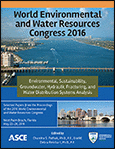Analysis of Saltwater Intrusion and Recirculation of Seawater in a Vertically Anisotropic Coastal Aquifer
Publication: World Environmental and Water Resources Congress 2016
Abstract
At the seacoast in a coastal aquifer, freshwater from inland terrestrial sources discharges to the sea, flowing over denser seawater from marine sources that intrudes inland along the base of the aquifer. As the seawater flows inland, it mixes with the seaward flowing freshwater, is recirculated, and discharges back to the sea. The sum of the recirculated seawater and fresh groundwater discharge is called submarine groundwater discharge (SGD). Recirculated seawater can be a major component of SGD, affecting the salinity of the SGD discharged into coastal and estuarine systems. Based on dimensional analysis, three dimensionless ratios (LD, RD, and PR) that represent saltwater intrusion, the recirculation of seawater, and the percent of recirculated seawater that is contained in the SGD can be considered dependent variables in this problem. Two additional dimensionless ratios (az and rK) that represent the ratio of the freshwater inflow relative to the vertical density-driven buoyancy flux and the ratio of the vertical and horizontal hydraulic conductivities in the aquifer cross-section can be considered independent variables in this problem. Numerical experiments were conducted using SEAWAT to determine how LD, RD, and PR are related to az and r_K over a wide range of values of az = 0.1 to 10.0 and r_K = 0.01, 0.1, and 1.0. Based on the results of this investigation, LD, RD, and PR all increase as az and rK are decreased, and LD, RD, and PR all decrease to zero or near zero as az and rK are increased. Maximum values of LD, RD, and PR occur at az = 0.1 for rK = 0.01, and minimum values of LD, RD, and PR occur at az = 10.0 for r_K = 1.0. The maximum value of PR = 74.1 % at az = 0.1 and rK = 0.01 confirms the important contribution that recirculated seawater can make to SGD and its effect on increasing the salinity of SGD in a vertically anisotropic aquifer, particularly at relatively small values of az ~ 0.1. The minimum values for LD, RD, and PR, which approach zero and occur at the larger values of az, indicate that saltwater intrusion and the recirculation of seawater are significantly reduced in both isotropic and anisotropic aquifers at relatively large values of az ~ 10.0. In natural settings, aquifer properties such as horizontal and vertical hydraulic conductivities, aquifer thickness, freshwater inflows, and other properties can be quite variable. However, based on the results of this investigation, saltwater intrusion, the recirculation of seawater, and the percent of recirculated seawater in submarine groundwater discharge in such field-scale aquifers can be investigated and even predicted by quantifying the two independent dimensionless ratios az and rK.
Get full access to this chapter
View all available purchase options and get full access to this chapter.
Information & Authors
Information
Published In
Copyright
© 2016 American Society of Civil Engineers.
History
Published online: May 18, 2016
Authors
Metrics & Citations
Metrics
Citations
Download citation
If you have the appropriate software installed, you can download article citation data to the citation manager of your choice. Simply select your manager software from the list below and click Download.
